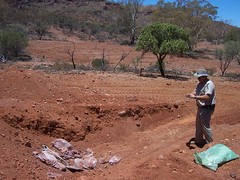 In the absence of an active drilling program, would-be Wilderness Sanctuary miner Marathon Resources seem to have elected to mine a seam of black humour instead.
In the absence of an active drilling program, would-be Wilderness Sanctuary miner Marathon Resources seem to have elected to mine a seam of black humour instead.How else can one explain the recent spate of hand-wringing mea culpas they've been issuing to their shareholders and the public in general?
Marathon's Chairman Peter Williams - who has been with the company since 2004 - tells us, in his open letter to Shareholders of August 15th;
I have led Marathon's review process to understand how this Mt Gee incident occurred and what we needed to learn. The results of this review, "Marathon Resources: Learning from Waste in the Wilderness", is being made public so that our key stakeholders can hear from us about our understanding of what happened and what we plan to do to ensure that these types of incidents do not recur.
Throughout the review process, I came to the difficult realisation that this incident may in fact have been symptomatic of our culture and Marathon's overall approach...
Our conclusion after the Mt Gee issue was that these incidents indicated we had not instilled the appropriate level of awareness about the importance of our social licence to operate. When the company formed in 2004, we should have worked harder to instil a culture, capability and systems for managing exploration in a way that was sensitive to the community and the environment. We needed management and communication that were up to delivering us this culture and approach.
Of course, one can scarcely argue with this admission that they certainly haven't made the grade in Arkaroola.
(As for 'Learning from Waste in the Wilderness'!? Give me a break!...)
But, equally obviously, this is all part of a strategy aimed at convincing us that they're reformed characters now, and that if the state government and community would only be prepared to let them back into the Arkaroola Wilderness Sanctuary to drill again they'd be the bestest little environment and community friendly mining company ever -
To win the right back to drill, we must first change our understanding of the priorities for an exploration company in a sensitive environment. We must be able to rebuild support with key stakeholders through better management and communication. We must ensure our standards of behaviour are exemplary and that we deliver our exploration program to the highest safety, environmental and community standards.
'Delivering the highest safety, environmental and community standards'. Haven't I heard this somewhere before? Haven't they been saying that's what they were doing all the way along? And look what happened!
But now they're back, and this time they're really, really on the wagon!
Frankly, I don't buy it, and I doubt that anyone else will either. Can they really expect to be taken seriously if they more-or-less say "Oh, we've suddenly realised we really had to not screw up if we were going to be allowed to prospect for Uranium in the heart of a Wilderness Sanctuary and one of the state's major tourist drawcards!"?
"Well, duh!"
The company knew perfectly well what it was getting into in Arkaroola. They knew that prospecting to establish a mine, and a Uranium mine in particular, was always going to be highly controversial, and that the state government - already under intense community scrutiny for allowing them access in the first place - would have no choice but to rigorously hold them to account.
the lessons of 'wild dog'
They'd already been through the whole 'Wild Dog' experience: Marathon had attempted to prospect for Uranium in the Myponga Reservoir catchment on the Fleurieu Peninsula near Adelaide. The local community were not at all impressed, and the Premier himself intervened directly - as he has conspicuously failed to do in this instance - making it quite clear that there would be no Uranium mine on the Fleurieu Peninsula.
How could they not have 'got' that Uranium prospecting is unpopular, and that prospecting in areas that the public have a great attachment to is doubly so?
The answer is that they did get it. And they also knew perfectly well that as they shifted their focus to the Arkaroola Wilderness Sanctuary the rigorous scrutiny would only increase. They even quoted Minerals Minister Paul Holloway in their own press release of November 2006 acknowledging that they wouldn't be pursuing the Wild Dog prospect at Myponga -
However, it needs to be understood that any new mines across the State will be developed within South Australia’s stringent regulatory framework of best practice environmental management and community consultation.
Now, that's pretty clear, isn't it? And they've published it themselves.
the company, in its own words
In fact, a quick spin through their own website reveals a continual litany of claims to adherence to the highest standards with regard to the environment and the community from that point on. I've included a number of examples below -
29th January 2007, Quarterly Activity Report
Marathon is acutely aware of its environmental and social responsibilities and this part of the scoping study is recognised as crucial and requiring attention at the earliest possible stage of the project. The Company is committed to exploration and mining with minimal environmental and social impact, recognising that its social license to operate depends from the outset on maintaining an environmental and social balance that is as close to original as practicable.
13th March 2007; CEO John Santich delivers a presentation to InvestorTV -
Obviously we’ll be going through the normal processes, and there’s going to be a lot of attention on Mount Gee. We’re going to be looking at the political, social, environmental considerations, but we’ll just have to pay a lot of attention to them.
3rd of April 2007; Mt Gee Uranium Project Update -
Dr Santich said that the Company was committed to environmentally sustainable mining at Mt Gee and to thorough exploration of the Paralana Mineral System. “Indications are that we already have a viable mine,”he said, “but we believe that we have only scratched the surface.”
“We consider the Paralana Mineral System has the potential to be one of the great uranium systems in Australia,”said Dr Santich. “We are committed to both the environment in the Flinders Ranges and to adding shareholder value through best practice mining,”he said.
31st August 2007; Update on mount Gee, announcing the formation of their new Community Consultation Committee -
A visit was recently undertaken by the CEO, Stuart Hall, to meet local community members in the vicinity of Mt Gee in preparation for the formation of a North Flinders Community Consultative Committee (NFCCC).
The NFCCC comprises local members from the State and Federal Government (or their alternates) and representatives of local landowners, graziers, tourism operators and the indigenous community. The aim of the Committee is to act as a forum for the company and the local community to regularly meet and discuss progress at Mt Gee and any issues of concerns that may arise.
walking the talk
25th of September 2007; in the Company's Annual Report we find the Chief Executive Officer's Report, which is worth quoting at some length -
We are confident in our ability to develop and operate the Mt Gee project in a safe and environmentally benign manner with careful consideration of the social, cultural and financial impact on local stakeholders.
Our vision is to make the operation a strong positive influence on the local community. We have adopted a four-pronged approach to ensure that this occurs:
1. Community
The principles of our approach to the community are:
• Engagement
• Openness
• Honesty
• Acknowledgement of alternative views
• Contribution to the community
• Earned respect
We believe that it is vital that the local community hear first-hand from Marathon about our plans and our progress. It is equally important that people have an open and transparent mechanism to air any concerns.
For this reason we have established the North Flinders Community Consultative Committee [ see above ]...
2. Environment
The principles of our approach to the environment are:
• To strive for best practice
• To be proactive in planning
• To stay ahead of community standards
As the proponents for the development of a uranium mine, we recognise that the community and the Federal and State Governments expect Marathon to consistently achieve the highest levels of environmental excellence.
Accordingly, our approach to environmental issues is reflected as a priority in our corporate values, in our recruitment and in our selection of consultants and contractors.
Marathon has offered to prepare a full Environmental Impact Statement of Mt Gee and to allow full public scrutiny of this document. This will lay the groundwork in establishing our environmental credentials and ensuring the highest standards are maintained throughout project development.
…
4. People
The principles of our approach to people are:
• Technical excellence and experience.
• To build a team of like-minded people.
• To ‘Walk the talk’.
• To develop suitable induction and training for our contractors and new staff.
Marathon will successfully implement our strategy with the full engagement of our staff. We intend to provide them with the appropriate training and tools to inculcate a culture of excellence in community liaison and environmental and safety standards.
So, all the same bases as those now being sold as the 'new improved' version of the operation are already specifically covered.
'Best Practice' in the environment, listening to the community, ensuring staff and contractors know exactly what its all about, acknowledging the legitimate intense scrutiny and highest expectations from both state and federal governments.
It could hardly be clearer. They had their chance - a chance many of us, after all, feel no company should ever have been given in Arkaroola in the first place - they knew exactly what was at stake... and they blew it, and got themselves suspended from drilling
environmental issues
Interestingly, the Directors Report section of this same Annual Report Document, signed by Peter Williams himself, contains the following
Environmental issues
The Group’s operations are subject to environmental regulation. The Group is satisfied that no breaches of environmental regulation have occurred.
Let's move on, shall we?...
15th of November 2007; Chairman's address to the Annual General Meeting, delivered by Peter Williams -
Marathon is also conscious of its need to gain a social “licence to operate”. We are confident in our ability to develop and operate the Mt Gee project in a safe and environmentally benign manner with due consideration of the social, cultural and financial impact on local stakeholders...
We have taken a four-pronged approach encompassing the community, environment, safety and human resources to ensure we gain stakeholder confidence and acceptance.
Building a world-class project with world-class environmental and safety standards is a challenging task, but we believe we have the right systems in place to achieve our goals.
Then, in December, Leigh Creek Police and the Sanctuary's owners make a first foray into the vast piles of material, including radioactive waste and left over laboratory personal protective equipment[!], buried in blatant contravention of the terms of the company's Exploration Lease, right in the heart of the Wilderness Sanctuary! And the rest is history...
It is abundantly clear that despite being fully aware of the inescapable centrality of maintaining their 'social licence to operate' from the first, and despite constant assurances that they were meeting the highest standards, the company couldn't, or wouldn't, in fact rise to either.
It is also abundantly clear in the light of this that the state government's policy of allowing mineral exploration in a Wilderness Sanctuary in the first place was irrevocably flawed. One cannot put foxes in charge of henhouses and claim to have the welfare of chickens at heart! There can be no 'second chances' - the Arkaroola Sanctuary must be fully protected now and for ever.

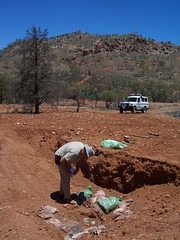
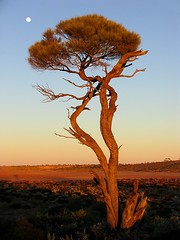
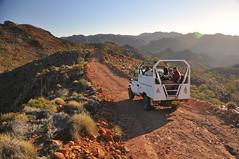
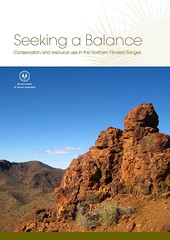
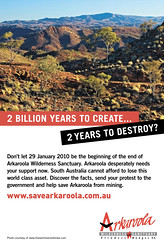
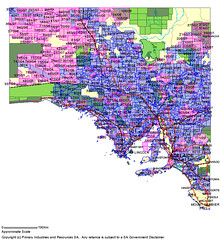
![link to the u[n]sa homepage](http://users.chariot.net.au/~greenh/blog/unknownsa_ublog-text.gif)


![link to the u[n]sa features page](http://users.chariot.net.au/~greenh/blog/features_ublog-text.gif)
![link to the u[n]sa kangaroo island feature image pages](http://farm2.static.flickr.com/1306/1187313059_93fdefd86b_o.jpg)
![link to the u[n]sa katarapko creek / murray river np feature image pages](http://farm2.static.flickr.com/1435/1181073355_b5c45f799d_o.jpg)


!['constellation' - wild country [national] set on flickr](http://farm1.static.flickr.com/155/415123844_3e6da621e5_s.jpg)

!['the bay serene' - the wild west [coast] set on flickr](http://farm1.static.flickr.com/121/312226516_606ac35455_s.jpg)








![u[n]sa journal -thanks for your time! u[n]sa journal - thanks for your time!](http://users.chariot.net.au/~greenh/blog/journal_ublog-text.gif)